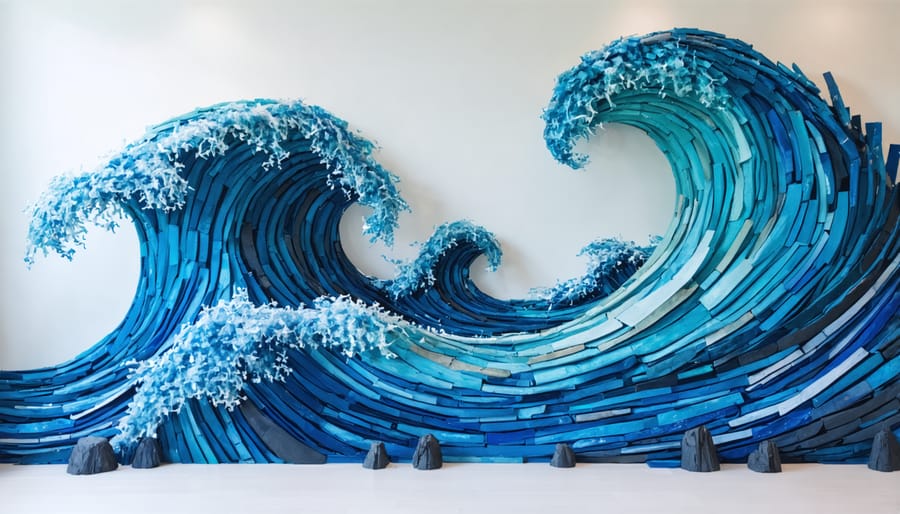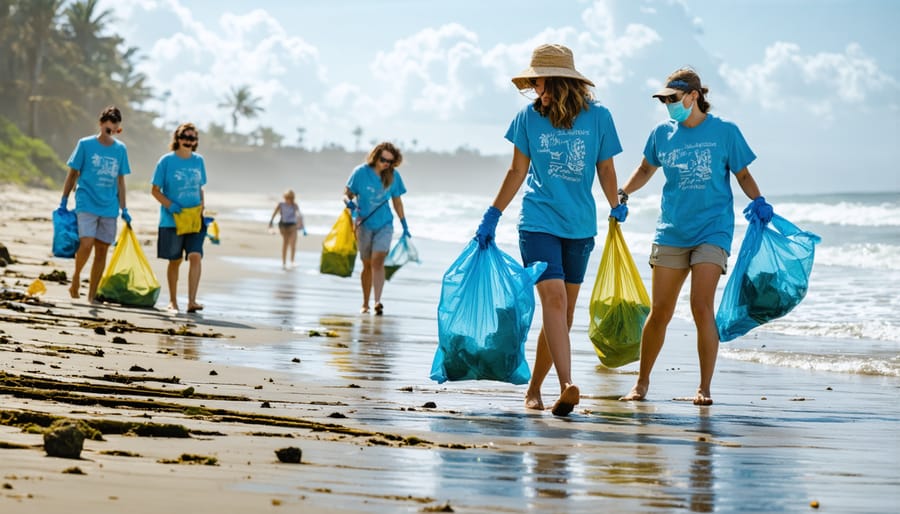
Along coastlines worldwide, communities are redefining their relationship with the ocean as the impacts of marine debris reshape generations of maritime heritage. From Mediterranean fishing villages to Pacific island nations, traditional marine identities—once shaped by harvesting and seafaring—now increasingly revolve around conservation and stewardship. This evolution reflects a profound shift in how coastal peoples view their role as ocean guardians rather than mere resource extractors.
The transformation is particularly evident in places like Indonesia’s Coral Triangle, where former fishing communities now lead marine protected area initiatives, and Cornwall, England, where maritime traditions dating back centuries have evolved to embrace sustainable practices. Young people in these regions are forging new connections with their marine environment, combining ancestral knowledge with modern conservation science to address unprecedented environmental challenges.
This cultural metamorphosis represents more than just adaptation; it embodies a revolutionary approach to marine stewardship where local identity and environmental protection become inseparable. As coastal communities worldwide grapple with marine pollution, their evolving relationship with the ocean offers valuable lessons about resilience, adaptation, and the power of cultural identity to drive environmental change.
Their story is not just about loss or change—it’s about transformation and hope, demonstrating how traditional maritime cultures can evolve to meet modern environmental challenges while maintaining their essential connection to the sea.
The Evolution of Marine Identity
Traditional Maritime Heritage
For centuries, coastal communities worldwide have shaped their identities through their deep connection with the sea. This traditional maritime heritage encompasses everything from fishing practices and boat-building techniques to navigation skills passed down through generations. In many regions, entire communities have organized their lives around the rhythms of tides, seasonal fish migrations, and maritime trade routes.
The relationship between coastal peoples and marine resources has historically defined not just their livelihoods, but their entire cultural fabric. From the traditional fishing villages of New England to the pearl divers of the Persian Gulf, these communities developed unique customs, celebrations, and social structures centered on their marine environment. Local knowledge of weather patterns, fishing grounds, and marine ecosystem dynamics became crucial survival skills, deeply embedded in community wisdom.
This maritime identity manifested in distinctive architectural styles, craft traditions, and culinary practices that reflected the abundance and challenges of life by the sea. Songs, stories, and artistic expressions celebrated the courage of seafarers and the bounty of ocean harvests, creating a rich cultural tapestry that continues to influence coastal communities today.

Modern Challenges to Marine Identity
Modern coastal communities are experiencing a profound shift in their relationship with the ocean due to the growing crisis of marine pollution. Where once the sea represented primarily a source of sustenance and cultural identity, many communities now find themselves grappling with beaches littered with plastic waste and waters contaminated by industrial runoff. This transformation has forced a reevaluation of traditional maritime practices and cultural connections.
In response, many coastal societies are incorporating environmental stewardship into their marine identity. Traditional fishermen are becoming citizen scientists, monitoring water quality and marine debris levels. Cultural festivals now often include beach cleanup events, combining celebration with conservation. This evolution reflects a growing understanding that protecting marine ecosystems is essential for preserving cultural heritage.
Young generations in particular are redefining their communities’ relationship with the ocean. Rather than seeing marine debris as a disconnection from their maritime roots, they’re embracing roles as ocean guardians. Through social media campaigns, educational programs, and community initiatives, they’re creating a new dimension of marine identity that combines traditional values with environmental consciousness.
This adaptation demonstrates the resilience of maritime cultures and their capacity to evolve while maintaining their essential connection to the sea.
Marine Debris as a Cultural Catalyst
Art and Expression
In coastal communities worldwide, artists and activists are transforming marine debris into powerful statements about ocean conservation and cultural identity. Local artisans collect plastic bottles, fishing nets, and other waste materials washing up on their shores, reimagining these environmental hazards as raw materials for creative expression.
From massive sculptural installations depicting marine life to intricate jewelry crafted from sea glass, these artistic interventions serve multiple purposes. They raise awareness about marine pollution, preserve traditional crafting techniques, and provide alternative income sources for fishing communities affected by declining catches.
In the Pacific Islands, traditional weavers incorporate found plastic materials into their designs, creating a poignant commentary on how modern waste impacts their ancestral waters. Similar initiatives in coastal Brazil see fishing communities creating vibrant murals from bottle caps and microplastics, each piece telling a story of their changing relationship with the ocean.
These artistic transformations have sparked a global movement, with marine debris art exhibitions appearing in prestigious galleries and museums. Environmental education programs increasingly use this approach to help students understand marine pollution’s impact while encouraging creative problem-solving.
The practice has evolved beyond mere artistic expression into a form of cultural resistance and adaptation, demonstrating how communities maintain their maritime heritage while addressing modern environmental challenges. These artifacts serve as powerful reminders of both human impact on marine ecosystems and our capacity for positive change through creative solutions.

Community Action
Coastal communities worldwide have developed innovative responses to marine debris, transforming environmental challenges into opportunities for cultural expression and community building. In many regions, regular community beach cleanups have evolved beyond simple waste collection into social events that strengthen local bonds and create new traditions.
The Pacific Islands, for instance, have integrated traditional navigation practices with modern conservation efforts. Local fishermen now combine their ancestral knowledge of ocean currents with debris mapping, helping scientists track pollution patterns while maintaining their maritime heritage. In coastal Thailand, artisans have pioneered the “Trash to Treasure” movement, where marine debris is transformed into traditional crafts and contemporary art pieces, creating a powerful statement about ocean conservation while preserving cultural practices.
Japanese coastal communities have developed the “Umi-no-Hi” (Ocean Day) festivals, where traditional maritime celebrations now incorporate educational programs about marine debris. These events feature workshops on sustainable fishing practices alongside centuries-old customs, demonstrating how environmental awareness can enhance rather than replace cultural identity.
These initiatives show how communities are adapting their maritime traditions to address modern environmental challenges, creating new cultural narratives that embrace both conservation and heritage. The result is a strengthened sense of place and purpose, where addressing marine debris becomes an integral part of coastal identity.
Transforming Crisis into Cultural Strength
Education and Awareness
Marine debris awareness has become increasingly integrated into educational programs and community initiatives worldwide, transforming how coastal communities perceive their relationship with the ocean. Schools in coastal regions are incorporating marine debris studies into their science curricula, helping students understand both the environmental impact of pollution and their community’s traditional connection to the sea.
Local maritime museums and cultural centers now regularly feature exhibits that contrast historical maritime traditions with current marine debris challenges. These installations often showcase art created from collected beach waste, serving as powerful visual representations of how human activity affects marine environments.
Community-led beach cleanup programs have evolved beyond simple waste collection to become educational opportunities. During these events, participants learn to identify different types of marine debris, understand their origins, and discover how local traditions of ocean stewardship can help address modern environmental challenges.
Many coastal communities have revived traditional practices of responsible resource use, incorporating them into modern conservation efforts. For example, some Pacific Island communities combine ancestral fishing practices with contemporary marine debris monitoring, creating a unique blend of cultural heritage and environmental protection.
Social media campaigns and digital storytelling initiatives have also emerged as powerful tools for sharing marine debris awareness across generations. These platforms allow communities to document their changing relationship with the ocean while inspiring global audience participation in marine conservation efforts.
Sustainable Practices
A remarkable transformation is occurring in coastal communities worldwide as new traditions emerge around environmental stewardship. Local fishing communities, once focused primarily on harvest, are now leading marine conservation efforts through innovative sustainable practices. These evolving customs blend traditional maritime knowledge with modern conservation awareness.
In the Mediterranean, fishers have established “no-take zones” during spawning seasons, turning these periods into cultural celebrations of marine renewal. Communities organize festivals that honor both their fishing heritage and their commitment to ocean preservation, featuring sustainable seafood tastings and educational workshops.
Along the Pacific coast, indigenous communities are reviving traditional selective fishing methods while incorporating modern tracking technology. They’re teaching younger generations about responsible harvesting through hands-on experiences and storytelling sessions, creating a new narrative that emphasizes harmony with marine ecosystems.
Coastal cleanup initiatives have evolved beyond simple beach sweeps into regular community gatherings. These events now include artistic installations created from collected debris, workshops on reducing plastic consumption, and ceremonies acknowledging the ocean’s importance to local identity. Many communities have established annual “Ocean Guardian” ceremonies, where young people pledge to protect marine environments and learn traditional ecological knowledge from community elders.
These emerging practices demonstrate how maritime communities are redefining their relationship with the sea, creating a new cultural identity that balances traditional values with environmental responsibility.

Personal Stories from the Shore
Dr. Maria Santos, a marine biologist with 15 years of experience studying coral reefs in the Pacific, shares her perspective: “The ocean has always been more than just my workplace – it’s part of who I am. Growing up in a coastal town, I learned to read the tides before I could read books. Now, as I work to protect these ecosystems, I see how our identity as coastal people is changing with the challenges we face.”
Similar sentiments echo throughout maritime communities worldwide. James Chen, a third-generation fisherman from Hong Kong, reflects on his evolving relationship with the sea: “My grandfather taught me to navigate by the stars and respect the ocean’s rhythms. Today, I’m teaching my children different lessons – how to participate in beach cleanups and protect marine life from plastic pollution. Our connection to the sea isn’t just about harvesting anymore; it’s about preservation.”
Sarah O’Connor, who leads citizen science initiatives in Ireland, describes how local identity has transformed: “In our small fishing village, people used to identify themselves purely as fishers or boat builders. Now, many proudly call themselves ‘ocean guardians.’ Every weekend, you’ll find families documenting marine species, monitoring water quality, and organizing community cleanups. It’s become part of our modern maritime culture.”
The story of the Maori community in New Zealand provides another powerful example. Elder Hemi Thompson explains: “Our people have always been kaitiaki (guardians) of the sea. But today, this traditional role has taken on new meaning. We’re combining ancient knowledge with modern conservation techniques, teaching young people that protecting marine life is essential to preserving our cultural identity.”
These personal accounts reveal how marine identity is evolving in response to environmental challenges. Dr. Lisa Martinez, a marine anthropologist, notes: “What we’re seeing is not the dissolution of maritime culture, but its adaptation. Communities are redefining their relationship with the ocean, incorporating conservation into their traditional practices and passing these new values to future generations.”
The transformation is particularly evident in youth initiatives. Sixteen-year-old Maya Patel, who founded a student marine conservation group in California, represents this new generation: “The ocean isn’t just something we visit or use – it’s something we protect. That’s become a core part of who we are as coastal residents.”
The relationship between marine debris and cultural identity continues to evolve, shaping how coastal communities view themselves and their connection to the ocean. What was once primarily defined by traditional maritime activities like fishing, shipping, and seaside recreation has transformed into a complex narrative that includes environmental stewardship and waste management.
Today’s marine identity increasingly incorporates a sense of responsibility for ocean health. Communities that once saw the sea primarily as a source of livelihood now recognize their role as guardians of marine ecosystems. This shift reflects a growing awareness that our relationship with the ocean must balance resource use with conservation.
The presence of marine debris has paradoxically strengthened some communities’ connection to their maritime heritage. Beach cleanup initiatives, citizen science projects, and marine conservation programs have created new traditions and social bonds. These activities have become integral to coastal culture, bringing together different generations and fostering a shared commitment to ocean protection.
Looking ahead, we must embrace this evolving marine identity while taking concrete action to address the challenges of marine debris. Every individual can contribute by participating in local cleanup efforts, supporting sustainable fishing practices, and making conscious choices about plastic consumption. Educational programs and community workshops offer opportunities to engage with marine conservation while strengthening cultural ties to the ocean.
The future of marine identity lies in finding harmony between traditional maritime heritage and modern environmental stewardship. By acknowledging this dual responsibility, we can work together to preserve both our cultural connections to the sea and the marine ecosystems that sustain us. Your involvement, whether through volunteering, education, or daily choices, helps shape this new chapter in our relationship with the ocean.
jessica
Ava Singh is an environmental writer and marine sustainability advocate with a deep commitment to protecting the world's oceans and coastal communities. With a background in environmental policy and a passion for storytelling, Ava brings complex topics to life through clear, engaging content that educates and empowers readers. At the Marine Biodiversity & Sustainability Learning Center, Ava focuses on sharing impactful stories about community engagement, policy innovations, and conservation strategies. Her writing bridges the gap between science and the public, encouraging people to take part in preserving marine biodiversity. When she’s not writing, Ava collaborates with local initiatives to promote eco-conscious living and sustainable development, ensuring her work makes a difference both on the page and in the real world.
